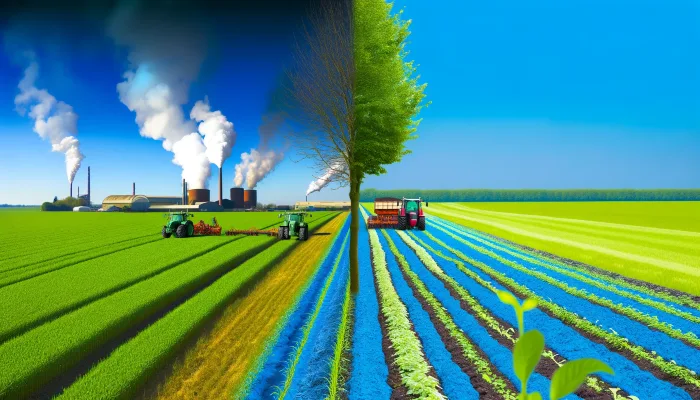Nearly $2 Billion in 'Green' Farming Subsidies Fail to Cut Emissions, Investigation Finds
In an eye-opening analysis, it turns out that over half of the U.S. federal dollars earmarked for so-called “climate-smart” farming might not be as smart after all. Aimed at slashing emissions from agriculture, a hefty sum of nearly $3 billion was allocated to support farmers in this green transition.
Yet, a startling $1.9 billion of that fund is being channeled into practices that, rather than mitigating the climate crisis, could potentially exacerbate it. This revelation comes from the Environmental Working Group (EWG), a non-profit organization dedicated to environmental issues, which took a hard look at where these funds are actually going.
The focus of EWG’s scrutiny is the Environmental Quality Incentives Program (EQIP), a major conservation effort by the U.S. Department of Agriculture (USDA). EQIP’s mission is to back farming practices that either cut down emissions or help in carbon sequestration. However, the reality seems to be at odds with the intention, especially in light of the additional $8.45 billion boost from the Inflation Reduction Act designated for “climate-smart” initiatives within EQIP through 2026.
Anne Schechinger, the agricultural economist behind the report, points out a significant gap between the program’s goals and its outcomes. “A lot of that money will end up going to practices that don’t actually have proven climate benefits,” she warns. This misallocation of funds isn’t just a missed opportunity, but a critical oversight, given that agriculture accounts for more than 10% of the U.S.’s greenhouse gas emissions. With a significant portion of these emissions stemming from livestock and the use of fertilizers, the need for genuine climate-smart farming practices has never been more urgent.

Diving deeper into the complexities of “climate-smart” agriculture funding, it becomes clear that not all practices receiving support are making the positive environmental impact they promise. While the goal is to lower the agriculture sector’s greenhouse gas footprint, the reality is a mix of effective and questionable allocations of funds.

Proven climate-friendly practices such as planting cover crops and creating grassed waterways have shown real promise in reducing erosion and protecting soil, with nutrient management standing out as a particularly effective method.
This approach ensures fertilizers are used more efficiently, minimizing waste and environmental harm. Yet, a significant portion of the funding from the Environmental Quality Incentives Program (EQIP) is being directed towards practices with dubious benefits for the climate, such as installing sprinkler systems and fences for animal containment.
More concerning is the support for provisional practices that, by the USDA’s admission, might actually increase greenhouse gas emissions. The construction of animal waste storage facilities, which have received over $252 million in funding, poses a risk of waterway contamination. Despite the USDA’s stipulation that these facilities adopt compost-bedded pack structures to cut methane emissions, the broader implications of promoting livestock production raise alarms among experts.
Silvia Secchi, a sustainability researcher, critiques the USDA’s approach, suggesting it inadvertently supports the expansion of dairy operations and other livestock production, which could negate any potential climate benefits. This perspective casts doubt on the efficacy and intentions behind the “climate-smart” label applied to such practices.
The USDA, however, defends its methodology and selection process, emphasizing a science-based approach to ensure the climate benefits of supported practices. USDA spokesperson Allan Rodriguez argues that the Environmental Working Group’s (EWG) report fails to recognize the depth of analysis and specificity involved in implementing these practices.
The debate over what qualifies as “climate-smart” agriculture has even reached the halls of Congress, with Senator Cory Booker leading a call for the USDA to reconsider its inclusion of livestock-related practices, particularly waste storage, on its climate-smart list.
This concern is shared by prominent figures like Elizabeth Warren and Alexandria Ocasio-Cortez, who emphasize the environmental and community health risks posed by large-scale manure storage.
Another contentious point is the funding for irrigation pipelines, touted for their energy efficiency but criticized for potentially exacerbating water scarcity and drought conditions, especially in the Western U.S. Critics argue that such practices shouldn’t be branded as “climate-smart” without clear evidence of their environmental benefits.
This situation underscores a broader challenge in aligning agricultural practices with climate goals.
As the USDA continues to navigate these criticisms, the call for a more transparent and data-driven approach to defining and supporting truly climate-smart agriculture grows louder.
More To Discover
The debate highlights the tension between agricultural innovation and environmental preservation, stressing the need for careful scrutiny and adaptation of policies to genuinely address the climate crisis.
Source: Environmental Working Group




















